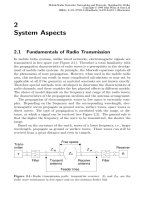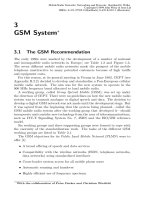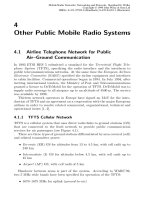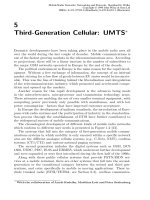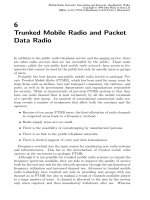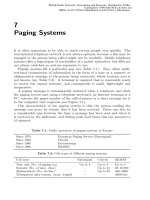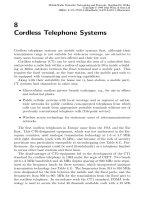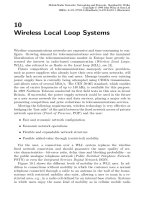Tài liệu Điện thoại di động mạng lưới Radio P8 ppt
Bạn đang xem bản rút gọn của tài liệu. Xem và tải ngay bản đầy đủ của tài liệu tại đây (182.27 KB, 6 trang )
8
Cordless Telephone Systems
Cordless telephone systems are mobile radio systems that, although their
transmission range is not suitable for wide-area coverage, are attractive to
many users because of the services offered and their low cost.
Cordless telephony (CT) can be used within the area of a subscriber line,
and provides a radio link within a radius of approximately 50 m inside a build-
ing or 300 m outdoors between the fixed terminal and a mobile part. This
requires the fixed terminal, as the base station, and the mobile part each to
be equipped with transmitting and receiving capabilities.
Along with their suitability for home use (a base station, a mobile part),
CT systems lend themselves to other uses:
• Microcellular cordless private branch exchanges, e.g., for use in offices
and industrial plants.
• Public cellular systems with local coverage and as regional or nation-
wide networks for public cordless coin-operated telephones from which
calls can be made from appropriate portable terminals without use of
previously conventional telephone cells (Telepoint service).
• Wireless access technology for stationary users of telecommunications
networks.
The first cordless telephones in Europe came from the USA and the Far
East. This CT0-designated equipment, which was not authorized in the Eu-
ropean countries, used analogue transmission technology at 1.6 or 4.7 MHz
with eight channels (each with 25 kHz), and because of the lack of security
provisions was particularly susceptible to eavesdropping (see Table 8.1). Fur-
thermore, the equipment could be used (fraudulantly) as a telephone handset
to access other base stations and their lines.
The disadvantages of CT0 equipment led to the development of the CT1
standard for cordless telephony in 1983 under the aegis of CEPT. Two bands
with a 2 MHz bandwidth and 45 MHz duplex spacing at 900 MHz were stipu-
lated as the frequency bands for these systems, which incorporated analogue
transmission technology (see Table 8.1). The frequencies from 914 to 916 MHz
were designated for the link between the mobile and the fixed parts, and the
frequencies from 959 to 961 MHz for the transmission from the fixed part to
the cordless telephone. In accordance with the CT1 standard, FDMA tech-
nology is used to access the total 40 channels available, each with a 25 kHz
Mobile Radio Networks: Networking and Protocols. Bernhard H. Walke
Copyright © 1999 John Wiley & Sons Ltd
ISBNs: 0-471-97595-8 (Hardback); 0-470-84193-1 (Electronic)
454 8 Cordless Telephone Systems
Table 8.1: The main parameters of cordless analogue telephone systems
System CT0 CT1 CT1+
Signal transmission Analogue Analogue Analogue
Frequency band [MHz] 1.6/4.7 914–915 885–887
959–961 930–932
No. of channels 8.0 40 80
Bandwidth [MHz] 0.4 2 4
Channel spacing [kHz] 25 12.5
Access procedure FDMA FDMA FDMA
Duplex procedure FDD FDD FDD
Channel allocation Fixed Dynamic Dynamic
Cellular networks No Limited Limited
Max. transmitter power [mW] 10 10
Range [m] < 1000 < 300 < 300
Handover No No No
Capacity [Erl./km➨] 1.0 200 200
bandwidth. These channels are allocated dynamically; there is a fixed alloca-
tion of frequencies to individual devices or local areas.
It soon emerged that the number of channels available with the CT1 stan-
dard was inadequate for metropolitan areas, and this led to the decision by
different countries, including Germany, to introduce a system with 80 chan-
nels in accordance with the CT1+ standard in 1989. With CT1+ the mobile
part transmits to the fixed part in the 885–887 MHz frequency range, whereas
the frequencies between 930 and 932 MHz are used for the link between the
fixed part and the mobile device (see Table 8.1). An organizational channel
is being planned for CT1+.
Unauthorized access to the base station has been almost completely elimi-
nated with the CT1 and CT1+ standards because of a number of codes that
provide a clear identification between the mobile and fixed parts; however,
these systems are not fully protected from eavesdropping.
8.1 CT2/CAI and Telepoint
In contrast to other European countries, in the mid-1980s Great Britain
started using a version of cordless telephony incorporating the T-standard
from the USA. Because these systems did not provide adequate capacity (eight
channels) and there was concern about a foreseeable frequency collision with
GSM, Great Britain was not keen to continue with the CT1-standard, and a
digital standard for cordless telephony was developed at the initiative of the
network operator British Telecom.
With the aim of making cordless telephony attractive to a broad range of
customers, it was planned that CT2 terminals should also be used for Tele-
8.2 Technical Parameters of CT2/CAI 455
point applications. The Telepoint concept allows users with the appropriate
equipment to set up a connection to the public telephone network over a
Telepoint base station within a radius of up to 300 m of a public and highly
frequented area (pedestrian area, railway station, airport, shopping centre,
etc.), but with no facilities for receiving calls [1].
The CT2 standard is frequently supplemented with the abbreviation CAI
(Common Air Interface), which denotes a radio interface between the fixed
part and the mobile part developed by the Department of Trade and Indus-
try (DTI) in Great Britain with the participation of British industry. The
interface was required to enable existing non-compatible terminal equipment
to access the Telepoint service.
The CT2/CAI standard was designed with enough flexibility so that the
same handset can be used to make calls at an office, at home and to the
public network. CAI basically allows incoming as well as outgoing calls. The
restriction that exists with Telepoint, i.e., that only outgoing calls are possible,
is only due to the terms of the licence and not to any technological limitations.
CT2/CAI has now been adopted as an ETSI Interim-Standard.
8.2 Technical Parameters of CT2/CAI
Technically, CT2 is based on the CT1 standard; however, digital transmission
has been introduced (see Table 8.2). The system has more than 40 frequency
channels, each with a 100 kHz bandwidth, in the frequency range between 864
Table 8.2: The main parameters of cordless digital telephone systems
System CT2/CAI DECT
Signal transmission Digital Digital
Frequency band [MHz] 864–868 1880–1900
No. of channels 40 120
Bandwidth [MHz] 4 20
Channel separation [kHz] 100 1.728
Access procedure FDMA FDMA/TDMA
Duplex procedure TDD TDD
Channel allocation Dynamic Dynamic
Voice channels/carriers 1 12
Coding ADPCM 32 kbit/s ADPCM 32 kbit/s
Modulation data rate 72 kbit/s 1.152 Mbit/s
Modulation Two-level GFSK GFSK
Cellular networks Limited Yes
Max. transmitter power [mW] 10 250
Range < 300 < 300
Handover No Yes
Capacity [Erl./km➨] 250 10 000
456 8 Cordless Telephone Systems
and 868 MHz, which, unlike CT1, does not collide with other standardized
mobile radio services in Europe.
Two-level GFSK (Gaussian Frequency Shift Keying) is used for modula-
tion. The nominal bit rate per channel is 72 kbit/s, which means that data
transmission is also possible, albeit at a relatively low net rate.
CT2/CAI is the first ever mobile radio system in which the base station
as well as the mobile terminal transmit on the same radio channel. Yet the
two transmission directions are not separated by different frequencies; instead
the pingpong technique is employed, in which the transmission direction is
changed every millisecond on the same frequency. With this procedure, called
Time-Division Duplex (TDD), the expensive filters required with Frequency-
Division Duplexing (FDD) for switching transmission direction are replaced
by simple switches.
The functions of the protocols of layers 1 to 3 specified for the air interface
in the CAI standard correspond to those of the ISO/OSI reference model:
Layer 1 The specifications apply to the physical transmission system, includ-
ing modulation procedure, frame structure, synchronization, time be-
haviour and bit rate, along with channel selection and link control.
Layer 2 The tasks of this layer include error detection, error correction, mes-
sage acknowledgement, connection control and identification.
Layer 3 The functions and message elements of this layer are used in the sig-
nalling for connection control, similarly to the ISDN-D-channel protocol.
It is responsible for recognizing the type of messages, for setting up and
terminating calls and for maintaining connections.
Three logical subchannels are defined by the standard:
• The B-channel, in which speech and, with the use of a modem, data can
be transmitted.
• The D-channel, for signalling.
• The SYN-channel, which transmits information on bit and burst syn-
chronization.
Depending on the application, these subchannels are allocated different
channel capacities in four different socalled multiplex frames (see Figure 8.1)
[2].
Multiplex 1.2 This defines a 66-bit long burst of duration 1 ms that contains
64 B-channel bits and 2 D-channel bits. Since this frame is used with
an existing connection, there is no need for an SYN channel. If the
synchronism is lost when this operating mode is used, the connection
must be reinitialized. Because this burst is sent every 2 ms, the data
rate in the B-channel is 32 kbit/s and that in the D-channel 1 kbit/s.
8.2 Technical Parameters of CT2/CAI 457
Multiplex 2
24 bit 16 bit10 bit16 bit
D-Channel CHMP or Sync. D-ChannelPreamble
66 bit (1 ms)
D-Channel B-Channel D-Channel
1 bit 64 bit
1 bit
66 bit (1 ms)
68 bit (1 ms)
D-Channel
2 bit64 bit
B-Channel
2 bit
D-Channel
Multiplex 1.4
Multiplex 1.2
D +
10
P
8 10
DP
810
DP
8
D +
10
P
810
DP
8
D +
10
P
810
DP
8
D +
10
CHMP
2412
PCHMP
2412
P
12
P CHMP
24 12
P CHMP
24
P
6
Frame
No.
1
2
3
4
5
6
7
144-bit Frame (2 ms)
Sub-MUX 1 Sub-MUX 2 Sub-MUX 3 Sub-MUX 4
Like Frame1; Different Data in Channel D
Like Frame1; Different Data in Channel D
Like Frame1; Different Data in Channel D
Receive
Receive
CHMP = Channel Marker for Portable
P = Preamble on Synchronization-Channel
The first 20 bits of the D-Channel are repeated in each Sub-Mux period
In slots marked with ’+’ the D-Channel starts with a Synchronization Word
Multiplex 3 (Portable to Base)
Figure 8.1: The structures of the multiplex frames with CAI
Multiplex 1.4 This is set up similarly to the Multiplex 1.2 burst, although a
total of 68 bits are transmitted in 1 ms, of which four are D-channel bits.
Therefore the data rate on the D-channel is 2 kbit/s. This multiplex
frame is used with an existing connection if the base station and the
mobile device have indicated during call setup that they are able to
support the 68-bit long burst.
Multiplex 2 This is a 66-bit long burst consisting of 32 D-channel bits and 34
SYN-channel bits, and is used during normal call setup and to restore
an interrupted connection. A total of 16 kbit/s are available to the D-
channel and 17 kbit/s for the SYN-channel. The SYN-field consists of
a 10-bit long preamble, followed by one of three different 24-bit long
synchronization patterns—a so-called channel marker for portable.
Multiplex 3 This defines a 10 ms long burst that is used to set up and restore
a connection that has been initiated by a handset. Here 10 ms are
divided into five 2 ms long frames, each of which is subdivided into four
identical subframes. The first four frames contain 20 D-channel bits and
16 preamble bits in each subframe, whereas the fifth frame only contains
SYN-channel bits.
Since the B-channel is used for transmitting speech, the data rate is
32 kbit/s. Speech is coded through Adaptive Differential Pulse Code Mod-
ulation (ADPCM).

